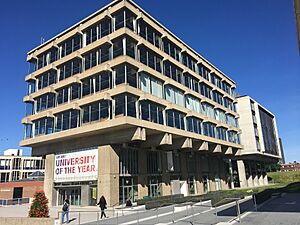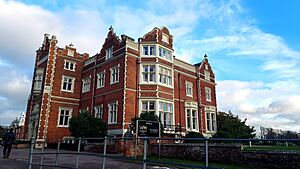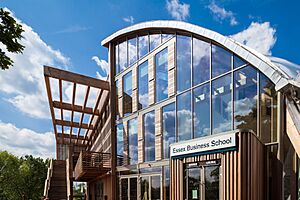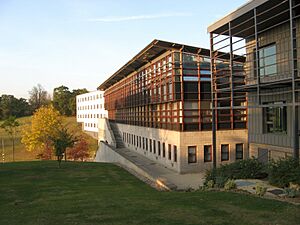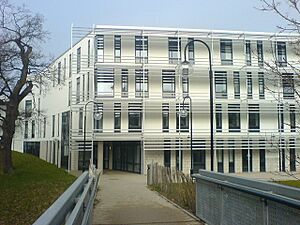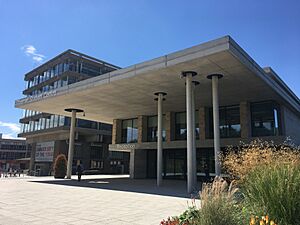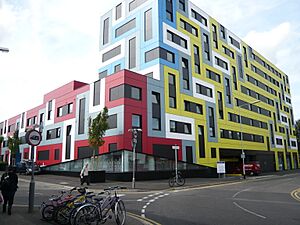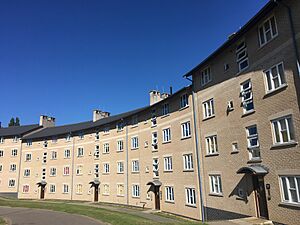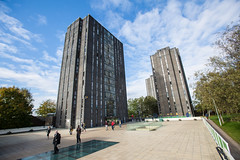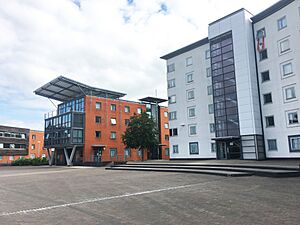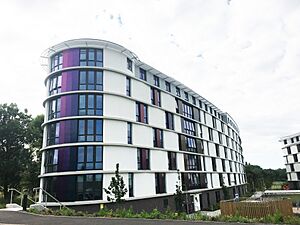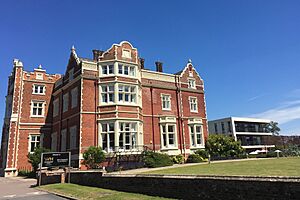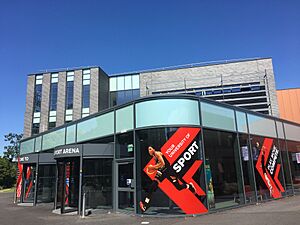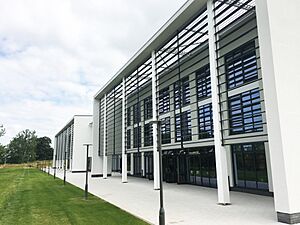University of Essex facts for kids
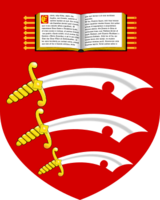
|
|||||||||||
| Motto | Thought the harder, heart the keener | ||||||||||
|---|---|---|---|---|---|---|---|---|---|---|---|
| Type | Public research university | ||||||||||
| Established | 1964 – the first academic year 1965 – received university status by royal charter |
||||||||||
|
Academic affiliations
|
AMBA Eastern ARC Young European Research Universities Network Universities UK |
||||||||||
| Endowment | £9.1 million (2023) | ||||||||||
| Budget | £317.8 million (2022/23) | ||||||||||
| Chancellor | Sarah Perry | ||||||||||
| Vice-Chancellor | Maria Fasli | ||||||||||
|
Administrative staff
|
2,562 full-time equivalent (2019–20) | ||||||||||
| Students | 17,000 (2022) | ||||||||||
| Undergraduates | 12,348 (2019–20) | ||||||||||
| Postgraduates | 2,577 (2019–20) | ||||||||||
| Location |
,
England
|
||||||||||
| Campus |
|
||||||||||
| Colours |
|
||||||||||
| Nickname | The Essex Blades | ||||||||||
| Mascot | Pebbles the Cat | ||||||||||
 |
|||||||||||
The University of Essex is a public research university located in Essex, England. It was officially started in 1965 and is known as one of the original "plate glass universities." These universities were built with modern designs, often using lots of glass and concrete.
The university has three main locations: its biggest campus is in Wivenhoe Park, Colchester, with others in Southend-on-Sea and Loughton. Essex is proud of its diverse student community, with students from many different countries. It also works with over 100 other universities around the world.
The University of Essex has received several awards. It was named "University of the Year" in 2018 by the Times Higher Education Awards. Its Department of Government was given a special "Regius Professorship" by Queen Elizabeth II in 2013. The university also won the Queen's Anniversary Prize twice, once for its work in human rights (2009) and again for its social and economic research (2017).
Many famous people have studied at the University of Essex, including Nobel Prize winners, a head of state, and important politicians.
Contents
Discovering the University of Essex
How Essex University Began
The University of Essex is one of seven "plate glass universities" that were built in the UK between 1961 and 1965. Its shield has the old symbols of the Kingdom of Essex. The university's motto, "Thought the harder, heart the keener," comes from an old Anglo-Saxon poem called The Battle of Maldon.
In 1959, the Essex County Council decided to create a university in the area. A special committee helped make this happen. At first, they thought about a different location, but in 1961, it was announced that the university would be built in Wivenhoe Park. The park was bought for the new university in December of that year.
Important leaders were chosen in 1962, including R. A. Butler as the first Chancellor and Albert Sloman as the first Vice-Chancellor. The first professors, who are like head teachers for university subjects, were appointed in 1963 for subjects like Physics, Mathematics, and Economics.
Money was raised to help build the university, and famous people like The Queen Mother and Sir Winston Churchill contributed. In 1964, the university chose red as its main color, and its special academic robes were designed by Sir Hardy Amies, who also designed clothes for the Queen.
Growing the University Campus
In October 1964, the first 122 students arrived at the university. There were 28 teachers and three main study areas: Comparative Studies, Physical Sciences, and Social Studies. Departments for subjects like Chemistry, Physics, and Government also opened. The first student leader was Denis Mesure.
By 1965, the number of students grew to 399, and there were 61 teachers. The first university degrees were awarded that year. Construction began on the library, which was later named the Albert Sloman Library. The Physics building opened, and the first student living tower, Rayleigh, was ready.
In 1966, more facilities opened, like the Hexagon Restaurant. By 1967, the number of students reached 750. Lord Butler officially became the Chancellor, and the first honorary degrees were given out. The university's special mace (a ceremonial staff) was carried for the first time.
Student Protests in 1968
In 1968, there were many protests around the world, including against the Vietnam War. Students at the University of Essex were part of these protests. In March 1968, students protested against a visit by a politician, Enoch Powell. Seven students faced punishment, but other students sat in to stop it.
Later, in May 1968, students protested a lecture by Dr. Thomas Inch, who worked at a place called Porton Down. Students believed his work was related to chemical and biological warfare. They managed to stop police from arresting anyone.
Three students were suspended without being told why or given a chance to defend themselves. In response, students picketed the university entrances and declared a "Free University." After a week, the three students were allowed back. Many Essex students also joined protests in Paris that summer.
Growth in the 1970s and 80s
During the 1970s and 1980s, the university continued to grow. It added a health center, a nursery for children, a bookstore, and new student homes. New departments like Law, Human Rights, and Biological Sciences were also opened.
The university started to focus its teaching into larger departments and worked with local companies on research projects. Because of its growing reputation, more and more international students came to study at Essex.
In 1987, Martin Harris became the new Vice-Chancellor. In the same year, Oscar Arias, a former student from the University of Essex, won the Nobel Peace Prize.
The 1990s and 2000s
In the 1990s, the university built more student housing as its student population increased. By 1993, for its 30th anniversary, Essex had 17 main departments, 5,500 students, and 1,300 staff. It also had important research centers like the UK Data Archive. More student apartments were built in a new student village.
Between 2003 and 2004, the university continued to expand. New student housing called University Quays opened. A new campus was also opened in Southend-on-Sea.
The Ivor Crewe Lecture Hall, a very large lecture theater with 1,000 seats, opened in 2006. It was designed by a famous architect, Patel Taylor. The building was named after Sir Ivor Crewe, who was the Vice-Chancellor for many years.
In 2007, the Gateway Building opened at the Southend Campus, providing facilities for the Essex Business School and the East 15 Acting School. The university also turned an old church into Clifftown Studios for acting students.
The Social Science Research Centre was finished in 2007. In 2009, the Centre for Brain Science opened for the Department of Psychology.
2010 to Today
In 2015, the Essex Business School opened a new building. It was the UK's first "zero-carbon" business school, meaning it was designed to have no negative impact on the environment. It has a special indoor garden and recycles rainwater.
The Silberrad Student Centre and the Albert Sloman Library were also expanded in 2015. These new parts were designed to match the original "Brutalist" style of the campus buildings.
In 2018, a STEM Centre opened to bring together the university's science departments. New student accommodation called The Copse also opened. In 2019, an Innovation Centre opened, providing space for over 50 new technology businesses.
In 2013, Queen Elizabeth II gave the university a special "Regius Professorship" to recognize its excellent work in political science for 50 years.
In 2019, Essex joined seven other European universities to form the Young Universities for the Future of Europe (YUFE) Alliance. This group aims to create "European Universities" that work together across borders to promote European values.
Campus and Buildings
The main campus is located in Wivenhoe Park, which was painted by the famous artist John Constable in 1816. The park includes the main 1960s university buildings and Wivenhoe House, an 18th-century mansion that is now a hotel and a hotel school.
The university's buildings are known for their "Brutalist architecture," which uses a lot of concrete and glass. This style was popular in the 1960s. The architect, Kenneth Capon, was inspired by the Italian town of San Gimignano, which has many towers. The university has six residential towers for students.
Important buildings include the residential towers, The Hexagon, and the Albert Sloman Library. The library was even chosen as an "icon of British design" in a 2012 exhibition. It also has one of the few working "paternoster lifts" in the country, which is a special type of elevator with open compartments that move continuously.
In 2014, an exhibition called "Something Fierce" celebrated the university's 50th anniversary and its unique architecture. The newer buildings, like the Silberrad Student Centre and the Essex Business School, were designed to fit in with the original Brutalist style.
How the University is Organized
The University of Essex is divided into three main faculties, which contain 21 schools and departments. These cover subjects in Humanities, Social Sciences, and Science and Health.
Key Study Areas
Here are some of the main departments and schools at the university:
- Department of Economics
- Department of Government
- Department of History
- Department of Language and Linguistics
- Department of Literature, Film, and Theatre Studies
- Department of Psychology
- Department of Sociology and Criminology
- Edge Hotel School
- Essex Business School
- School of Biological Sciences
- School of Computer Science and Electronic Engineering
- School of Health and Social Care
- School of Law
- School of Mathematics, Statistics and Actuarial Science
- School of Philosophy and Art History
- School of Sport, Rehabilitation and Exercise Science
- East 15 Acting School
- UK Data Archive
Special Research Centers
Essex has special centers that bring together experts from different subjects to do research. These include:
- Human Rights Centre: Started in 1982, this center works to promote human rights around the world.
- Institute for Analytics and Data Science: This institute works with businesses and governments on managing and using large amounts of data.
- Institute for Social and Economic Research (ISER): This center studies how people's lives change over time, looking at things like their jobs and attitudes.
- Institute of Public Health and Wellbeing: This center works on improving public health and wellbeing through research.
Important Departments
Essex Law School
The Essex School of Law is highly ranked in the UK and worldwide for its teaching and research.
Essex Business School
The Essex Business School was the first "carbon-zero" business school in the UK, meaning it's very environmentally friendly. Its MBA program is well-recognized globally.
Department of Government
The Department of Government at Essex is consistently ranked as one of the best in the UK for political science research. It has several research centers and hosts the Essex Summer School for Social Science Data Analysis.
Department of Sociology and Criminology
This department was one of the first at the university, started in 1964. It studies how societies work and how crime affects them.
East 15 Acting School
The East 15 Acting School became part of the university in 2000. It is based in Loughton and Southend-on-Sea. It is known as one of the top drama schools in the UK and is very diverse, with students from many different backgrounds.
Edge Hotel School
The Edge Hotel School is unique because it has a real four-star hotel on campus. Students get hands-on experience working in the hotel while they study. It also offers courses in events management.
School of Computer Science and Electronic Engineering
This school was formed in 2007 by combining two older departments. It is known for its research in areas like Artificial Intelligence (AI).
UK Data Archive
The UK Data Archive is a national center in the UK for collecting and preserving digital data, especially in social sciences. It started in 1967.
Working with Others
The University of Essex works closely with many other universities and organizations both in the UK and around the world.
For example, it is part of the Young Universities for the Future of Europe (YUFE) alliance, which brings together young European universities to work on shared goals. Essex also has partnerships with universities in China, France, Germany, Japan, Russia, and Singapore, offering special degree programs.
The university also works with Kaplan Singapore and Kaplan Open Learning to offer online degrees and preparation courses for international students.
Essex has also teamed up with the University of East Anglia and the University of Kent to form the Eastern Arc research group, focusing on research related to the United Nation's Sustainable Development Goals.
University Achievements
The University of Essex has a strong reputation for teaching and research. It was named "University of the Year" in 2018 by the Times Higher Education Awards. It also won an award in 2019 for its international work with Amnesty International on investigating human rights violations.
Essex has won the Queen's Anniversary Prize twice: in 2009 for its work in human rights, and in 2017 for its important social and economic research that helps governments make better policies.
The university has grown significantly and is known for its international outlook, with many students and staff from outside the UK. Its Summer School in Social Science Data Analysis and Collection has been running for over 50 years, teaching thousands of students and faculty from around the world.
Essex has been highly rated for its research quality and student satisfaction. In 2017, it received a "Gold" rating in the Teaching Excellence Framework (TEF), which means it provides excellent teaching and helps students succeed.
Famous People from Essex
| National rankings | |
|---|---|
| Complete (2021) | 29 |
| Guardian (2021) | 23 |
| Times / Sunday Times (2021) | 46= |
| Global rankings | |
| ARWU (2020) | 501–600 |
| QS (2021) |
456= |
| THE (2021) | 351–400 |
| British Government assessment | |
| Teaching Excellence Framework | Gold |
The University of Essex has produced two Nobel Prize winners. This is a big achievement for a university!
- Óscar Arias, a former President of Costa Rica, won the Nobel Peace Prize in 1987 after studying political science at Essex.
- Christopher Pissarides won the Nobel Prize in Economics in 2010. He studied economics at Essex in the 1970s.
- Oliver Hart, a former academic at Essex, also won the Nobel Prize for Economics in 2016.
Other notable alumni include:
- John Bercow, who was the Speaker of the House of Commons in the UK Parliament.
- Architect Daniel Libeskind, who helped redesign the World Trade Center site in New York City.
- Filmmaker David Yates, who directed several Harry Potter movies.
- Novelist Ben Okri, who won the Booker Prize.
Many graduates from Essex have become professors at universities around the world. It's even estimated that about half of the sociology professors in UK universities have studied at Essex!
Life as a Student
Student Community
|
The University of Essex has a very international student body. In 2017–18, over 4,300 students were from outside the UK, representing 132 different countries. This makes Essex a truly global place to study.
Students' Union and Activities
The Students' Union at Essex has hosted many famous music bands over the years, including AC/DC, Blur, Iggy Pop, The Kinks, Pink Floyd, and Radiohead.
Students at Essex voted in 2017 to leave the National Union of Students. In 2018, they decided to change how their own Students' Union works, creating a Student Parliament to represent them. The Students' Union also has its own media channels called Rebel, including Rebel Radio, which has won awards.
Sports at Essex
Sports are a big part of student life at Essex. There are many ways to get involved in physical activity, which helps with health and wellbeing.
The university's competitive sports teams are called the Essex Blades. There are over 40 clubs for various sports, including football, rugby, basketball, and even unique ones like korfball and disc golf.
Essex focuses on "high-performance" sports like volleyball, basketball, and rugby. They offer scholarships to talented students in these sports.
The men's volleyball team won the National Student Cup three times in a row from 2017 to 2019. The women's basketball team also won the National Cup in 2016 and the National League title in 2018. In 2019, the men's volleyball team became the first Essex team to win the British University and Colleges (BUCS) championship national final.
In 2018, the university opened the new Essex Sport Arena at the Colchester Campus. This is a top-level sports venue with seating for 1,650 people. It hosts basketball, volleyball, and other sports. It is also home to the Essex Rebels Women's Basketball team, which plays in a professional league.
The university works with national sports organizations like the Football Association and England Rugby. Great Britain teams also use Essex's facilities for training.
The Colchester Campus also has one of the oldest disc golf courses in the UK, which has hosted international championships.
Once a year, Essex students compete against the University of East Anglia in a "Derby Day" sports contest.
Working with Businesses
Knowledge Gateway Park
Essex has created the Knowledge Gateway research and technology park at its Colchester Campus. The goal is to create jobs and help new businesses grow. It includes office buildings and an Innovation Centre that supports over 50 start-up technology companies.
Knowledge Transfer Partnerships
The university helps businesses connect with its academic experts. Essex is a leading university in the East of England for "Knowledge Transfer Partnerships," which are projects that help businesses use university research to improve their products or services.
Images for kids
-
Óscar Arias, former president of Costa Rica, and recipient of the Nobel Peace Prize in 1987
-
Christopher A. Pissarides, the joint Nobel Prize in Economics recipient in 2010
-
John Bercow, former Speaker of the House of Commons (United Kingdom) (2009–2019)
-
Architect Daniel Libeskind
-
Ifeanyi Ossai, Present Deputy Governor of Enugu State, Nigeria
-
Hoshyar Zebari, former Minister of Foreign Affairs for Iraq
-
Rodolfo Neri Vela, a Mexican scientist and astronaut who flew aboard a NASA Space Shuttle mission in 1985
See also
 In Spanish: Universidad de Essex para niños
In Spanish: Universidad de Essex para niños


